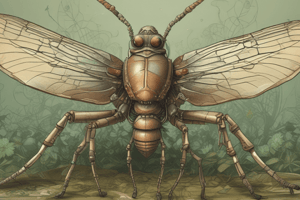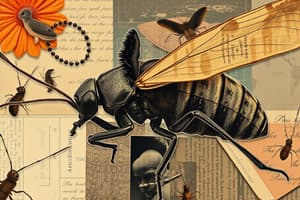Podcast
Questions and Answers
Which of the following statements accurately reflects the epidemiological significance of Pseudolynchia canariensis within avian populations?
Which of the following statements accurately reflects the epidemiological significance of Pseudolynchia canariensis within avian populations?
- It acts as a definitive host for various species of avian malaria, contributing to the propagation of the disease.
- It primarily serves as a mechanical vector for arboviruses, exhibiting high vector competence for West Nile Virus.
- It facilitates the horizontal transmission of avian influenza viruses via direct contact during feeding on bird hosts.
- It is a known vector of _Haemoproteus columbae_, a widespread avian blood parasite, impacting pigeon health and racing performance. (correct)
Considering the ecological dynamics of Triatoma spp., what nuanced aspect of their behavior most significantly contributes to their vectorial capacity in the context of Trypanosoma cruzi transmission?
Considering the ecological dynamics of Triatoma spp., what nuanced aspect of their behavior most significantly contributes to their vectorial capacity in the context of Trypanosoma cruzi transmission?
- Their utilization of diverse vertebrate hosts, including both mammals and birds, enhancing parasite amplification and dispersal.
- Their defecation during or immediately following a blood meal, facilitating parasite entry through inoculation into the bite wound or mucosal surfaces. (correct)
- Their tendency to aggregate in peridomestic environments, creating localized foci of high vector density and pathogen transmission.
- Their strict nocturnal feeding habits, which coincide with peak human activity, leading to increased bite rates.
In the context of veterinary entomology, what is the most critical factor that differentiates the control strategies for Linognathus spp. infestations compared to those targeting Haematopinus spp.?
In the context of veterinary entomology, what is the most critical factor that differentiates the control strategies for Linognathus spp. infestations compared to those targeting Haematopinus spp.?
- The necessity of targeting all life stages of _Linognathus spp._, including the eggs, with ovicidal compounds, while _Haematopinus spp._ control primarily focuses on adulticidal treatments. (correct)
- The hematological feeding preferences of _Linognathus spp._ leading to increased likelihood of secondary bacterial infections requiring antibiotic prophylaxis.
- The consideration of host immune status in _Linognathus spp._ infestations, necessitating immunostimulatory therapies alongside insecticides, unlike _Haematopinus spp._ management.
- The exclusive reliance on systemic insecticides for _Linognathus spp._ due to their endophilic behavior, contrasting with topical treatments effective against _Haematopinus spp_.
Concerning the adaptive significance of morphological adaptations in Siphonaptera, which feature most critically impacts their ability to efficiently parasitize hosts within densely feathered or furred environments?
Concerning the adaptive significance of morphological adaptations in Siphonaptera, which feature most critically impacts their ability to efficiently parasitize hosts within densely feathered or furred environments?
Given the diverse host specificity exhibited by various species within the Polyplax genus, what is the most critical consideration in developing targeted control measures for these sucking lice?
Given the diverse host specificity exhibited by various species within the Polyplax genus, what is the most critical consideration in developing targeted control measures for these sucking lice?
What is the primary ecological distinction that differentiates the control methodologies employed against Cimex spp. in temperate climates versus those in tropical or subtropical regions?
What is the primary ecological distinction that differentiates the control methodologies employed against Cimex spp. in temperate climates versus those in tropical or subtropical regions?
Within the order Phthiraptera, what fundamental biological divergence explains the differential pathogenicity observed between Anoplura and Ischnocera infestations on mammalian hosts?
Within the order Phthiraptera, what fundamental biological divergence explains the differential pathogenicity observed between Anoplura and Ischnocera infestations on mammalian hosts?
Considering the unique physiological adaptations of Melophagus ovinus, what aspect of its metabolic processes is most vulnerable for exploitation by novel antiparasitic drugs?
Considering the unique physiological adaptations of Melophagus ovinus, what aspect of its metabolic processes is most vulnerable for exploitation by novel antiparasitic drugs?
How does the hemimetabolous development of Blattodea impact the strategic implementation of integrated pest management (IPM) programs compared to holometabolous insects?
How does the hemimetabolous development of Blattodea impact the strategic implementation of integrated pest management (IPM) programs compared to holometabolous insects?
Considering the vectorial capacity of Linguatula serrata, what is the most critical factor influencing its role in zoonotic transmission?
Considering the vectorial capacity of Linguatula serrata, what is the most critical factor influencing its role in zoonotic transmission?
How does the evolutionary history and phylogenetic relationships within the Acarina (ticks and mites) inform contemporary strategies for managing acaricide resistance?
How does the evolutionary history and phylogenetic relationships within the Acarina (ticks and mites) inform contemporary strategies for managing acaricide resistance?
Given the unique biology of Class Pentastomida, which strategy would be the most effective for controlling zoonotic transmission of Armillifer armillatus in endemic regions?
Given the unique biology of Class Pentastomida, which strategy would be the most effective for controlling zoonotic transmission of Armillifer armillatus in endemic regions?
Considering the diverse ecologies and life cycles of mites (Acari), what is the most critical factor influencing the successful implementation of biological control agents for mite infestations in agricultural systems?
Considering the diverse ecologies and life cycles of mites (Acari), what is the most critical factor influencing the successful implementation of biological control agents for mite infestations in agricultural systems?
Within the order Orthoptera, how does the acoustic communication behavior of certain species influence the efficacy of habitat management strategies aimed at reducing pest populations in agricultural settings?
Within the order Orthoptera, how does the acoustic communication behavior of certain species influence the efficacy of habitat management strategies aimed at reducing pest populations in agricultural settings?
How does an understanding of the evolutionary trade-offs between dispersal ability and host specialization in Hippoboscidae inform strategies for preventing the spread of these parasites among geographically isolated wildlife populations?
How does an understanding of the evolutionary trade-offs between dispersal ability and host specialization in Hippoboscidae inform strategies for preventing the spread of these parasites among geographically isolated wildlife populations?
Considering the public health implications of arthropod-borne diseases, what is the most significant challenge in implementing effective surveillance programs for emerging vector-borne pathogens?
Considering the public health implications of arthropod-borne diseases, what is the most significant challenge in implementing effective surveillance programs for emerging vector-borne pathogens?
Considering the role of Hymenoptera as both beneficial insects (pollinators, biological control agents) and pests, how can conservation biological control strategies be optimized to minimize non-target effects on beneficial Hymenoptera populations?
Considering the role of Hymenoptera as both beneficial insects (pollinators, biological control agents) and pests, how can conservation biological control strategies be optimized to minimize non-target effects on beneficial Hymenoptera populations?
In the context of One Health initiatives, what is the most critical consideration in developing integrated control strategies for zoonotic parasites transmitted by arthropod vectors?
In the context of One Health initiatives, what is the most critical consideration in developing integrated control strategies for zoonotic parasites transmitted by arthropod vectors?
Considering the implications of climate change on arthropod vector distributions, what is the most pressing research priority for mitigating the potential expansion of vector-borne disease risk in temperate regions?
Considering the implications of climate change on arthropod vector distributions, what is the most pressing research priority for mitigating the potential expansion of vector-borne disease risk in temperate regions?
Flashcards
Hippoboscidae
Hippoboscidae
Family of flies; some are parasitic on mammals and birds.
O. Hemiptera
O. Hemiptera
An order of insects; known as true bugs.
O. Orthoptera
O. Orthoptera
An order of insects; grasshoppers, crickets, and locusts.
O. Blattodea
O. Blattodea
Signup and view all the flashcards
O. Coleoptera
O. Coleoptera
Signup and view all the flashcards
O. Siphonaptera
O. Siphonaptera
Signup and view all the flashcards
O. Phthiraptera
O. Phthiraptera
Signup and view all the flashcards
Class Arachnida
Class Arachnida
Signup and view all the flashcards
O. Acarina
O. Acarina
Signup and view all the flashcards
Mites
Mites
Signup and view all the flashcards
Class Pentastomida
Class Pentastomida
Signup and view all the flashcards
Melophagus ovinus
Melophagus ovinus
Signup and view all the flashcards
Pseudolynchia canariensis
Pseudolynchia canariensis
Signup and view all the flashcards
Family Cimicidae
Family Cimicidae
Signup and view all the flashcards
Triatoma spp.
Triatoma spp.
Signup and view all the flashcards
Suborder Anoplura
Suborder Anoplura
Signup and view all the flashcards
Family Haematopinidae
Family Haematopinidae
Signup and view all the flashcards
Family Linognathidae
Family Linognathidae
Signup and view all the flashcards
Suborder Iscnocera
Suborder Iscnocera
Signup and view all the flashcards
Family Trichodectidae
Family Trichodectidae
Signup and view all the flashcards
Study Notes
- The following is an outline of topics related to arthropods within the context of biotransformation.
Family Hippoboscidae
- Consists of Melophagus ovinus, Pseudolynchia canariensis, Hippobosca spp., and other members.
- Control methods exist.
- Includes Family Streblidae and Nycteribiidae.
Order Hemiptera
- Includes Family Cimicidae, which consists of Cimex spp.
- Control methods exist for Cimex spp.
- Includes Family Reduviidae, which consists of Triatoma spp.
- Control methods exist for Triatoma spp.
Non-Parasitic Insects
- Includes Order Orthopera (Orthoptera), Order Blattodea (Blattaria), Order Coleoptera, and Hymenoptera.
Order Siphonaptera
- Fleas
Order Phthiraptera
- Includes sucking and chewing lice of mammals, and chewing lice of poultry
- Suborder Anoplura includes Family Haematopinidae (Haematopinus spp.) and Family Linognathidae (Linognathus spp, Solenopotes capillatus)
- Other sucking lice of animals include Polyplax spp., Pedicinus, Hoplopleura soo, Haemadipsus ventricosisis, and human lice.
- Chewing Lice, previously Order Mallophaga, is now Suborder Iscnocera.
- Family Trichodectidae Damalinia (=Bovicola_) includes Damalinia equi, D. ovis, D. limabata, D. caprae, D. bovis, Felicola subrostrata and Trochiodectes canis.
- Ischnocerate Lice are found on domestic birds.
Class Arachnida
- Includes O. Acarina: Tick Mites
- Includes Mites
Class Pentastomida
- Injurious non-parasitic arthropods
- Consists of Class Pentatosmida, which includes Family Linuatulidae (Linguatula serrata) and Family Porocephalidae (Armillifer armillatus, Porocephalus crotali).
- Also includes injurious arachnids like Scorpions and Spiders.
Studying That Suits You
Use AI to generate personalized quizzes and flashcards to suit your learning preferences.




